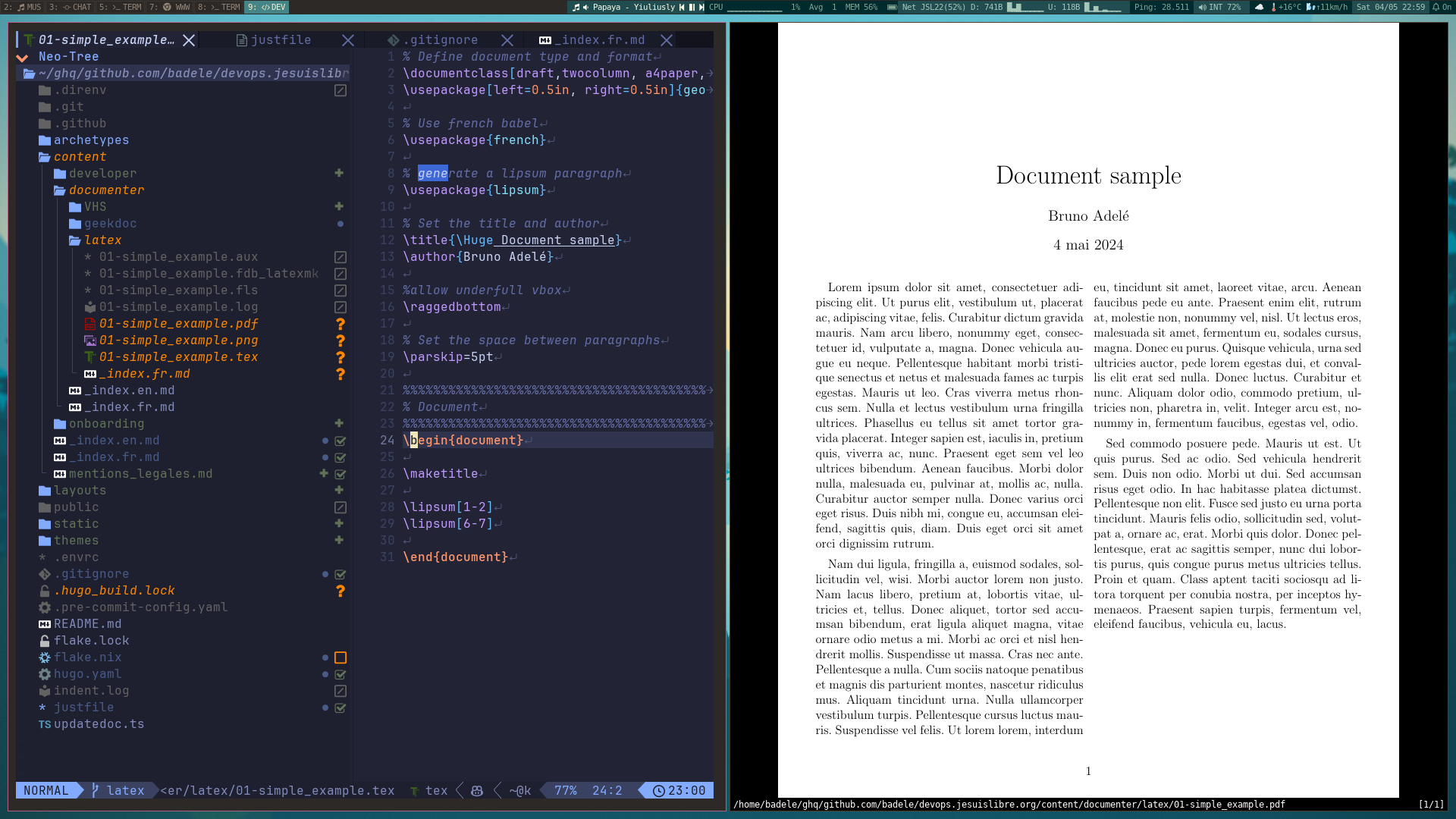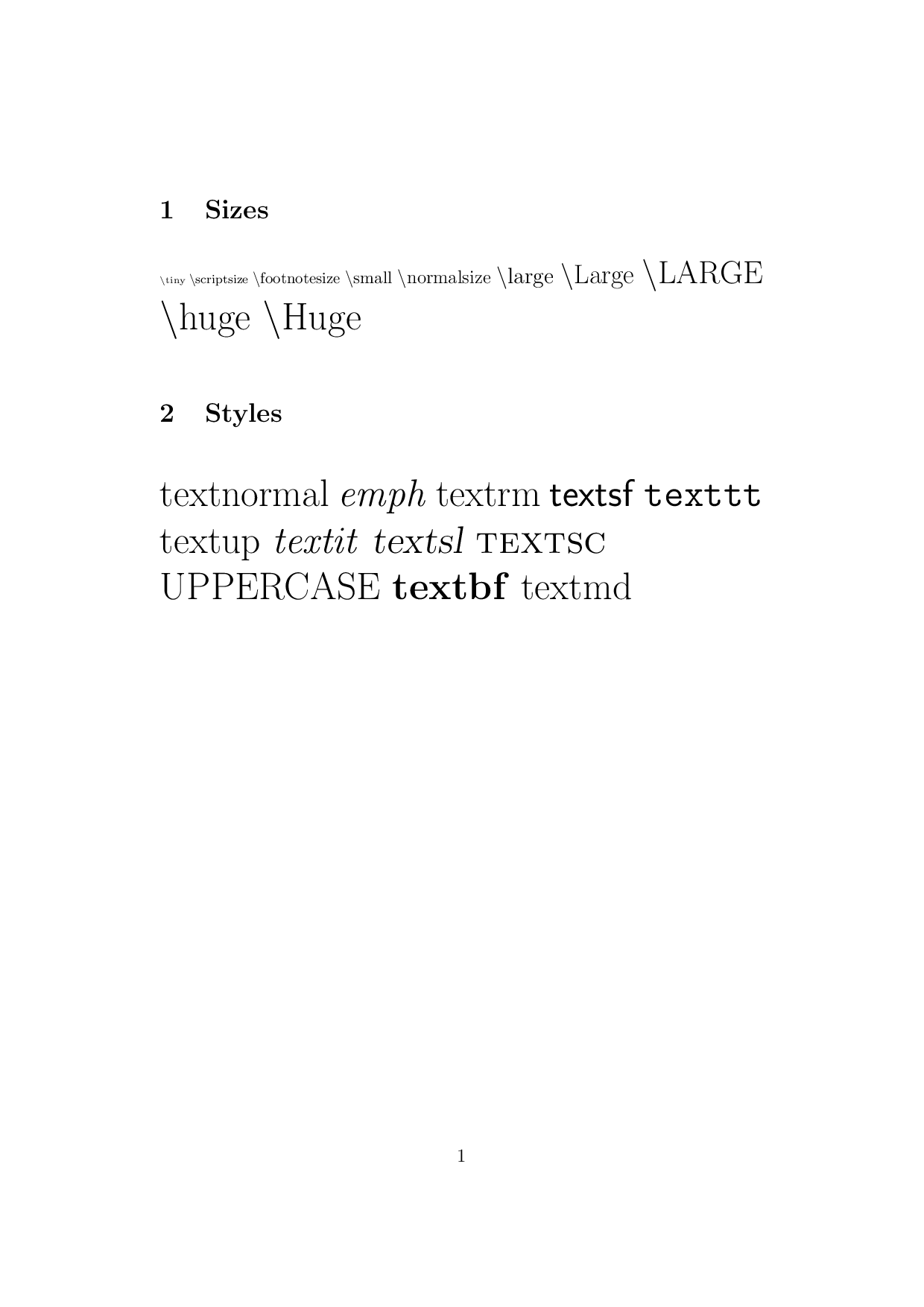Ceci est une ancienne révision du document !
Why LaTeX?
As a DevOps we like to master code generation, deployment generation and document generation. That's why LaTeX can be a good replacement for Office or LibreOffice.
Without any particular editor, the code in a LaTeX document is much easier to read than an Office/LibreOffice document, which are saved in the Office Open XML
Personally, although you can write LaTeX documents with an editor such as TeXstudio, you can also use simpler editors such as Nano or Vim. Personally, I use mon my own IDE, based on Vim, which not only lets me edit, reformat, linter and view LaTeX documents, but also, thanks to Nix, download LaTeX packages.
The preamble
The preamble is used to configure the form of the document and to indicate the additional packages to be downloaded and their configuration. The preamble is inserted between the start of the document and the command \begin{document} commandIt is used to define the document's global configurations, such as the document class, the packages to be used and the metadata.
Here is a simple example
% Define document type and format
% available class :article, report, book, letter, beamer
\documentclass[twocolumn, a4paper, 12pt]{article}
\usepackage[left=0.5in, right=0.5in]{geometry}
% Use french babel
\usepackage{french}
% generate a lipsum paragraph
\usepackage{lipsum}
% Set the title and author
\title{\Huge Document sample}
\author{Bruno Adelé}
\date{5 mai 2024}
%allow underfull vbox (allow empty space at the bottom of the page
\raggedbottom
% Set the space between paragraphs
\parskip=5pt
%%%%%%%%%%%%%%%%%%%%%%%%%%%%%%%%%%%%%%%%%%%%%%%%%%%%%%%%%%%%%%%%%%%%%%%%%%%%%%%
% Document
%%%%%%%%%%%%%%%%%%%%%%%%%%%%%%%%%%%%%%%%%%%%%%%%%%%%%%%%%%%%%%%%%%%%%%%%%%%%%%%
\begin{document}
\maketitle
\lipsum[1-2]
\lipsum[6-7]
\end{document}
The sections
Sections and subsections in LaTeX are used to organise a document into parts and sub-parts, similar to the way titles are structured in Office. It is also possible to generate a table of contents using the command \tableofcontents. It is also possible to include unnumbered sections in the table of contents by adding an asterisk as a suffix (section*{Title}).
% Define document type and format
% available class :article, report, book, letter, beamer
\documentclass[a4paper, 12pt]{article}
\listfiles
% Use french babel
\usepackage{french}
% generate a lipsum paragraph
\usepackage{lipsum}
% Set the title and author
\title{\Huge Sections list}
\author{Bruno Adelé}
\date{}
%allow underfull vbox
\raggedbottom
% Set the space between paragraphs
\parskip=5pt
%%%%%%%%%%%%%%%%%%%%%%%%%%%%%%%%%%%%%%%%%%%%%%%%%%%%%%%%%%%%%%%%%%%%%%%%%%%%%%%
% Document
%%%%%%%%%%%%%%%%%%%%%%%%%%%%%%%%%%%%%%%%%%%%%%%%%%%%%%%%%%%%%%%%%%%%%%%%%%%%%%%
\begin{document}
\maketitle
\tableofcontents
\section{Section}
\lipsum[1][-2]
\subsection{Subsection}
\lipsum[2][-2]
\subsubsection{Subsubsection}
\lipsum[3][-2]
\subsubsection*{Section without counter}
\addcontentsline{toc}{section}{Section without counter}
\lipsum[4][-2]
\begin{appendix}
\addtocontents{toc}{\setcounter{tocdepth}{2}}
\section{Annexes}
% \addcontentsline{toc}{section}{Annexes}
\subsection{Liste des ilustrations}
\listoffigures
\listoftables
\end{appendix}
\end{document}
Text style
Here is a range of text styles.
% Define document type and format
% available class :article, report, book, letter, beamer
\documentclass[a4paper, 12pt]{article}
% Use french babel
\usepackage{french}
% generate a lipsum paragraph
\usepackage{lipsum}
% Set the title and author
\title{\Huge Sections list}
\author{Bruno Adelé}
\date{}
\newcommand{\showsize}[1]{\csname #1 \endcsname $\setminus$#1}
%%%%%%%%%%%%%%%%%%%%%%%%%%%%%%%%%%%%%%%%%%%%%%%%%%%%%%%%%%%%%%%%%%%%%%%%%%%%%%%
% Document
%%%%%%%%%%%%%%%%%%%%%%%%%%%%%%%%%%%%%%%%%%%%%%%%%%%%%%%%%%%%%%%%%%%%%%%%%%%%%%%
\begin{document}
\section{Sizes}
\noindent \showsize{tiny}
\showsize{scriptsize}
\showsize{footnotesize}
\showsize{small}
\showsize{normalsize}
\showsize{large}
\showsize{Large}
\showsize{LARGE}
\showsize{huge}
\showsize{Huge}
\section{Styles}
\noindent \textnormal{textnormal} \emph{emph} \textrm{textrm} \textsf{textsf} \texttt{texttt} \textup{textup} \textit{textit} \textsl{textsl} \textsc{textsc} \\
\uppercase{uppercase} \textbf{textbf} \textmd{textmd}
\end{document}
A few tips
Debug
In the Preamble
draf, showframe
LaTeX is a tool that aims to produce optimal formatting for documents, but when it encounters rules that it cannot apply, it generates warnings or errors. However, these error messages can sometimes be difficult to understand. To resolve these problems, it is possible to activate a debug mode that provides additional information for understanding and correcting errors.
By adding the options draft and showframe options to the \documentclass commandcommand, you can display the borders of the boxes and black out any problem areas.
% Define document type and format
% available class :article, report, book, letter, beamer
\documentclass[draft, showframe, twocolumn, a4paper, 12pt]{article}
\usepackage[left=0.5in, right=0.5in]{geometry}
% Use french babel
\usepackage{french}
% generate a lipsum paragraph
\usepackage{lipsum}
% Set the title and author
\title{\Huge Document sample}
\author{Bruno Adelé}
\date{5 mai 2024}
%allow underfull vbox (allow empty space at the bottom of the page
\raggedbottom
% Set the space between paragraphs
\parskip=5pt
%%%%%%%%%%%%%%%%%%%%%%%%%%%%%%%%%%%%%%%%%%%%%%%%%%%%%%%%%%%%%%%%%%%%%%%%%%%%%%%
% Document
%%%%%%%%%%%%%%%%%%%%%%%%%%%%%%%%%%%%%%%%%%%%%%%%%%%%%%%%%%%%%%%%%%%%%%%%%%%%%%%
\begin{document}
\maketitle
\lipsum[3-5]
\lipsum[12]
\end{document}
listfiles
To list installed packages, simply add the command \listfiles in the preamble, at the next compilation via pdflatex you will get the list of files as command output.
*File List*
article.cls 2023/05/17 v1.4n Standard LaTeX document class
size12.clo 2023/05/17 v1.4n Standard LaTeX file (size option)
french.sty 2019/09/06 The e-french package /V6,11/
msg.sty 2019/01/01 chargement de l'extension de localisation (V0.51).
latexsym.sty 1998/08/17 v2.2e Standard LaTeX package (lasy symbols)
fenglish.sty 2004/06/23 english interface for the french(le/pro) package
lipsum.sty 2021-09-20 v2.7 150 paragraphs of Lorem Ipsum dummy text
l3keys2e.sty 2024-02-18 LaTeX2e option processing using LaTeX3 keys
expl3.sty 2024-02-20 L3 programming layer (loader)
l3backend-pdftex.def 2024-02-20 L3 backend support: PDF output (pdfTeX)
lipsum.ltd
t1lmr.fd 2015/05/01 v1.6.1 Font defs for Latin Modern
french.cfg
ulasy.fd 1998/08/17 v2.2e LaTeX symbol font definitions
***********
Miscellaneous
- List of fonts https://tug.org/FontCatalogue/allfonts.html
- Comprehensive LaTeX Symbol List http://mirrors.ctan.org/info/symbols/comprehensive/symbols-a4.pdf
Sources
-
- openai
- Reformulation of sentences
- Correction of spelling mistakes




